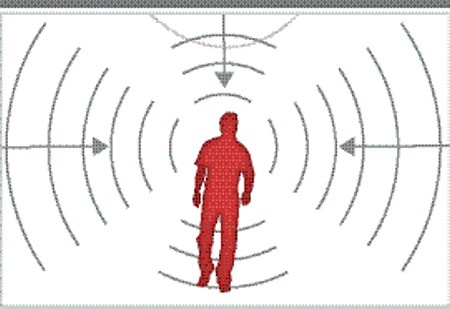As Master of Sound Julian Treasure says:
“Sound must be carefully considered in the design process, whether for a building or an environment…There is no time to lose in getting this message across to architects, planners, government, and those commissioning buildings: we are currently creating schools, hospitals, offices and urban spaces that are simply not fit for purpose… It's so much easier and cheaper to design in good acoustics, low noise and good sound systems at the start – and yet sound is rarely considered an important element of design, and even if it has been included, so often acoustics and sound systems are the first things to get 'value engineered' out of the project.”

IF ACOUSTIC DESIGN IS SO IMPORTANT, WHAT ARE THE KEY PRINCIPLES TO UNDERSTAND?
Large room, long reverberation time
As a rule of thumb, it is pretty safe to assume that the larger a room is; the longer the reverberation time will be. Long reverberation times are disruptive for dialogue or work, because the sound has nowhere to go – conversations are difficult and concentration is disturbed.
In large rooms avoid too many parallel surfaces which bounce sound back and forth between ceiling and floor and from wall to wall, creating a longer reverberation time.
Tips to help spread the sound and shorten the reverberation time:
Change the shape of the room to avoid parallel surfaces
Consider adding protrusions to the walls & ceilings
Fit sound diffusers to the walls and ceiling (or even to the floor)
Reducing noise with the right surface angle
When designing large spaces, like open plan offices, it is critical to keep the reverberation time and the general noise level to a minimum. However in such commercial buildings, large glass facades are typical – these hard surfaces reflect sound at the same angle it arrives. The result is a long reverberation time and a noise level so high that people simply cannot concentrate.
Tips to reduce noise levels and reverberation time:
Fit angled or sound diffusing elements to walls opposing glass facades and other hard surfaces
Alter the angle of the glass by just six degrees – if angled to reflect sound to the ceiling, absorbers installed on the ceiling will trap some of the sound.
Erect screens to curb some of the sound – this is a simple solution for people who make lots of phone calls as part of their work; a screen next to them can prevent the sound from the calls spreading to the rest of the room – works even better if there are also sound barriers in the ceiling.
.jpg)
THE IMPORTANCE OF THE CEILING IN ACOUSTICS
We have established that hard parallel surfaces send sound straight back to the source, so a ceiling that is not parallel with the floor can effectively manipulate sound. The shape of the ceiling is very important to the acoustics in a room and an incorrectly shaped ceiling can be very disruptive to the activity going on in the room.
Tips for ceiling shapes:
Consider vaulted or domed ceilings to focus the sound at a particular point – this can give the space an almost sacred character such as in churches and cathedrals.
Whereas concave shapes in the ceiling carry the sound around the dome, convex shapes spread the sound out in every direction.
Examples:
In the Whispering Gallery in St Paul’s Cathedral in London the concave shape carries the sound around the dome. You can stand in the dome and whisper to someone beyond the normal hearing range.
Stockholm Public Library, built in the 1920s also has a domed ceiling, creating a solemn and exalted atmosphere around the world of books and learning. These days, talking is allowed in libraries, and the atmosphere is more informal than it was a century ago. But this exposes the weaknesses of the structure – the sound stays suspended in the space for a long time, making it difficult to hold a conversation.
THE RATIO BETWEEN LENGTH AND WIDTH ALSO AFFECTS THE ACOUSTICS
We know room size is an important factor in determining reverberation time, but it is also significant for the character of the sound. The shape of a room also influences how sound behaves - it is more difficult to predict how sound will behave in a non-rectangular room than in a rectangular room. Some non-rectangular rooms enhance sound quality, while others can create unintended mirror points.
.jpg)
Tips for regulating reverberation time in different sized rooms:
In small, non-rectangular rooms with ample high frequency absorption, the low frequencies will be unpleasant, so the use of panel absorbers is needed.
Large, moderately furnished rooms benefit from broadband absorbers throughout the ceiling surface.
In large rooms, additional diffusion or barriers should be installed in the ceiling, as this is where the problem of sound propagation is at its greatest.
In rooms intended for two-way dialogue, do not dampen noise but aim to spread the sound without reflecting it back.
Room height also affects the quantity of sound absorbing material needed.
In rooms with low ceilings, sound waves hit the ceiling before the walls, so absorbers should be placed on the ceiling

In narrow rooms, sound hits the walls before the ceiling, so absorbers should go on the wall.
.jpg)
If a room is wide and high, the absorbers should be fitted above the normal storey height (2.5 m) and generally speaking, a larger number of absorbers or sound diffusers should be fitted to the walls.
On a final note it is worth considering rooms that are connected, where the sound in one room can influence the sound in the other. Here an acoustic transition between the rooms helps to ensure that the sound is not perceived as being very different from one room to the other. If the difference is too great, it can feel as if you have cotton wool in your ears as you move between rooms.
Another element that needs consideration when looking at reverberation time is of course the way the space will be used, as different types of usages don’t call for the same reverberation times.
Xem định vị:
- Tổng công ty: Cụm Công Nghiệp Lại Yên, Xã Sơn Đồng, TP. Hà Nội.
- Kho Mỹ Đình: Đối diện 304 đường K2, Cầu Diễn, Nam Từ Liêm, Hà Nội.
- VP Trường Chinh: Số 36, ngõ 120 đường Trường Chinh, phường Kim Liên, TP. Hà Nội.
- Nhà máy: KCN Bình Phú, Phường Kỳ Sơn, Tỉnh Phú Thọ.
- Chi nhánh Đà Nẵng: Số 575, Đường Lê Văn Hiển, Hòa Hải, Ngũ Hành Sơn, Đà Nẵng.
- Chi nhánh Sài Gòn: Số 181/7 Dương công khi, Ấp 9, xã Hóc Môn, TP. Hồ Chí Minh.
* Để rõ đường đi và thuận lợi cho đôi bên Quý khách vui lòng Click vào đây để xem chi tiết.